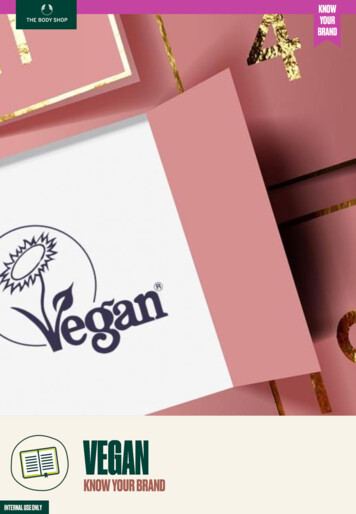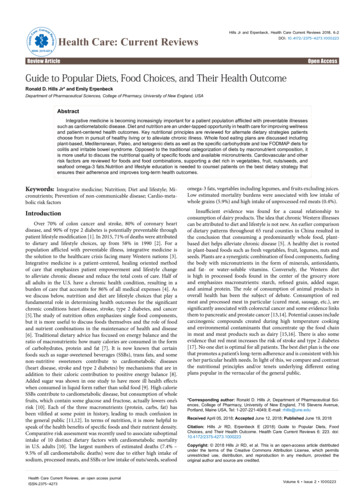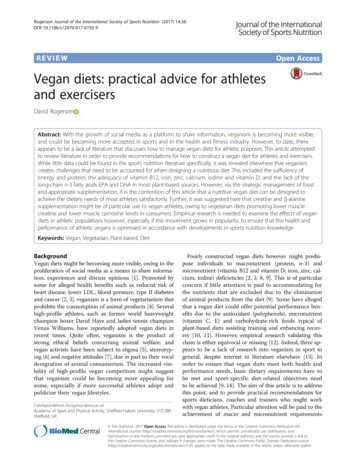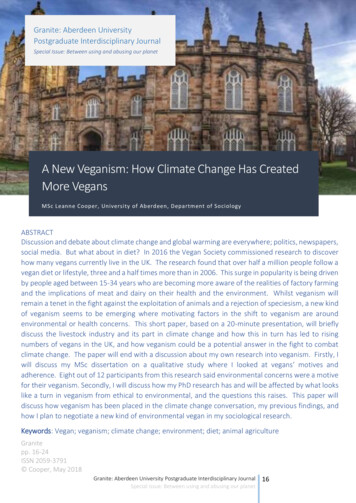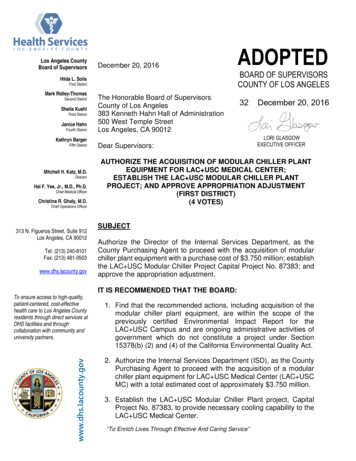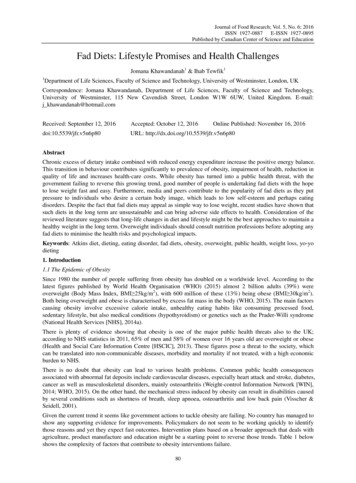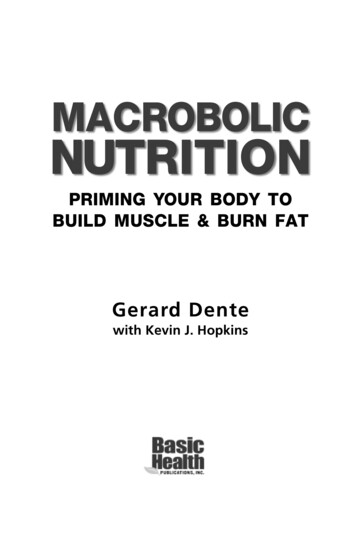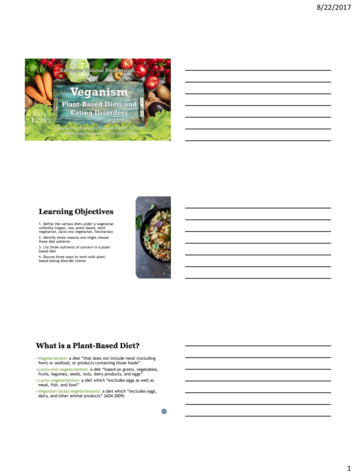
Transcription
8/22/20171. Define the various diets under a vegetarianumbrella (vegan, raw, plant-based, semivegetarian, lacto-ovo vegetarian, flexitarian)2. Identify three reasons one might choosethese diet patterns3. List three nutrients of concern in a plantbased diet4. Discuss three ways to work with plantbased eating disorder clients2 Vegetarianism: a diet “that does not include meat (includingfowl) or seafood, or products containing those foods” Lacto-ovo-vegetarianism: a diet “based on grains, vegetables,fruits, legumes, seeds, nuts, dairy products, and eggs” Lacto-vegetarianism: a diet which “excludes eggs as well asmeat, fish, and fowl” Veganism (total vegetarianism): a diet which “excludes eggs,dairy, and other animal products” (ADA 2009)31
8/22/2017 Pescatarian: does not include meat (including fowl) but does containseafood Flexitarian: Eats all foods, but ‘wakes up with the intention of beingvegetarian’ Meat Minimalist: Conscious effort to reduce animal protein intake Plant-Based: diet based on foods derived from plants, including vegetables,whole grains, legumes and fruits, but with few or no animal products. Raw: uncooked, unprocessed, mostly organic foods. Some eat unpasteurizeddairy foods, raw eggs, meat, and fish. Your food can be cold or even a littlebit warm, as long as it doesn't go above 118 degrees. Raw Vegan: does not include raw eggs, meat, fish or dairy-products.4 Ethical (non-violence) Ethical (food production) Environmental Religious Health Economic5 Orthorexia Nervosa: “an unhealthy obsession with otherwise healthyeating. Literally means ‘fixation on righteous eating’. Orthorexia [can]start out as an innocent attempt to eat more healthfully, but orthorexicsbecome fixated on food quality and purity” (Kratina 2016). Anorexia Nervosa: “an eating disorder characterized by weight loss,difficulties maintaining appropriate body weight for height, age, andstature, and in many individuals, distorted body image. People withanorexia generally restrict the number of calories and the types of foodthey eat” (NEDA 2016)62
8/22/2017 Can you follow a plant-based diet and recover from an eating disorder? Traditional dogma says no A study by Bardone-Cone et. al (2012) “found that nearly half of their participantswith a history of disordered eating reported following a vegetarian diet at some pointand cited weight control as a primary reason for this choice” (Barnett et. al. 2016). “Food rules”, restrictive eating behaviors, and special diets may mask eating disordersby making social acceptable exclusions (pescatarian, vegan, paleo, gluten-free, etc.)(Barnett et. al. 2016)7 A study by Timko, Hormes & Chubski (2012) “found that semi-vegetarians, as opposed to ‘true’ vegetarians, were more likelyto report a disordered relationship with food” (Barnett et. al.2016). The study done by Barnett et. al (2016) “suggests that even ifhighly engaged alternative food network (AFN) consumers are“obsessed” with healthy and pure foods, this preoccupationmay not manifest in disordered eating behaviors” (Barnett et.al. 2016) Environmental and animal welfare concerns are prominentmotivating factors for adopting a vegetarian diet (Bardone-Coneet. al. 2012; Fox & Ward 2008; Barnett et. al. 2016)8 College-age women filled out questionnaires about their eatingbehavior and their attitudes toward food. The women were classified as vegetarian (including vegan), pesco-vegetarian, semi-vegetarian (no red meat), flexitarian (limited redmeat), and omnivore. Semi-vegetarians and flexitarians showed more restrained eatingbehavior compared to both the omnivores and the vegetarians. The more restricted their diets -- the fewer animal products theyate—the less likely they were to show signs of disordered eating.93
8/22/2017 August 2012 issue of the Journal of the Academy ofNutrition and Dietetics on weight control and vegetariandiets. Women with a history of disordered eating are more likelyto have been vegetarian for weight control reasons thanwomen who had never had an eating disorder. Those who use vegetarianism as a way of reducing caloriesare more likely to experience disordered eating patternscompared to those who adopt vegetarian diets for otherreasons. Vegetarian, especially vegan diets, are often promoted as away to lose weight10How Do We Counsel These Clients? 2009 ADA position statement“It is the position of the American Dietetic Associationthat appropriately planned vegetarian diets, includingtotal vegetarian or vegan diets, are healthful,nutritionally adequate, and may provide healthbenefits in the prevention and treatment of certaindiseases. Well-planned vegetarian diets areappropriate for individuals during all stages of the lifecycle, including pregnancy, lactation, infancy,childhood, and adolescence, and for athletes”11 Adequate in certain nutrients, but lower in others (ADA 2009)“Vegetarian diets tend to be lower in saturated fat andcholesterol, and have higher levels of dietary fiber,magnesium and potassium, vitamins C and E, folate,carotenoids, flavonoids, and other phytochemicals.These nutritional differences may explain some of thehealth advantages of those following a varied, balancedvegetarian diet. However, vegans and some othervegetarians may have lower intakes of vitamin B12,calcium, vitamin D, zinc, and long-chain n-3 fatty acids”124
8/22/2017 Protein Vitamin B12 Vitamin D Calcium Iodine Omega-3 fatty ima beans, black-eyed peas, chickpeas), legumes (peas, edamame,hemp), nuts & nut butters, seeds (sunflower, pumpkin, chia), high-protein whole grains(rice, quinoa), meat alternatives (tofu, tempeh, seitan), vegetable-based proteinpowders, milk, yogurt, cheese, eggsVitaminB12Fortified products (cereals), nutritional yeast, cheese, yogurt, milk, eggsVitamin DSunlight, milk, yogurt, egg, fortified products (cereals, orange juice), cheese,supplemental D2 & D3 (animal derived)CalciumDark leafy greens, cabbage, broccoli, beans, nuts, seeds, tofu, milk, cheese, fortifiedfoods (non-dairy milks, orange juice,), cottage cheese, whole wheat bread14NutrientSourceIodineSeaweed, grains, milk, yogurt, cheese, eggs, salt (iodine fortified), soymilkOmega-3 FattyAcidsFlax seed, chia seed, hemp, walnuts, green leafy vegetables, algaesupplements, oils (canola, soybean, flaxseed) edamameIronbeans, soyfoods, nuts, seeds, winter squashes, dark leafy greenvegetables, dried fruits, oatmeal, quinoa and pearl barley155
8/22/20172:00 Snack- 1 grain-1 proteinBreakfast- 1 fruit- 1 protein- 2 grains- 1 milk- 1 fatDinner:- 3 Proteins- 2 Grains- 1 Veggie- 1 Fat- 1 Milk10:00 SNACK:- 1 fruit- 1 proteinLunch- 2 Proteins- 2 grains- 1 fruit- 1 veggie- 1 fat8:00 Snack- fruit/juice16Breakfast- 1 banana- 2 tablespoons peanut butter- 2 slices whole-grain toast- 1 cup calcium-fortified soy milk2:00 Snack- 1 ounces whole grain crackers-1/4 cup hummus194 calories, 26g CHO, 8g fat, 5g protein548 calories, 69g carbohydrates, 23g fat, 23g protein10:00 SNACK:- 1 apple- ½ cup steamed edamame166 calories, 27g CHO, 4g fat, 9g proteinLunch-1 veggie burger patty100% sandwich roll1 cup blueberrieslettuce, tomato, sliced cucumber¼ avocado1 cup baked sweet potato cubes605 calories, 100g CHO, 17g fat, 21g protein 2227 calories 350g CHO 63g Fat (11g saturated, 27gmonounsaturated, 19gpolyunsaturated) 89g proteinDinner: (Taco Bowl)-1 cup black beans1 cup brown rice1 cup steamed spinach leaves½ cup pico de gallo salsa¼ cup guacamole1 cup calcium-fortified soy milk673 calories, 110 CHO, 15g fat, 30g protein8:00 Snack- fruit juice sorbet bar171363mg calcium (136% RDA)23mg iron (128% RDA)14mg Zinc (171% RDA)5.4 µg Vitamin B12 (224% RDA)16g linoleic acid1g linolenic acid186
8/22/2017 Focus more on nutrition, less onlabels Just talk about food! Less likely to use labels themselves “Liberalizing” diet using veganversions for challenge Consider supplements Be honest with over-hypedclaims19 Consider personal bias Patients might be less likely to seek help if they feel you are working against them Cannot assume someone is vegetarian/vegan for an unhealthy reason “Meet patients where they are” in order to build trust, rapport, and compliance Giving them ACHIEVABLE, REALISTIC goals they can stick to will better help themrecover “To realize full recovery and to prevent relapse, it is important to consider not onlyeating behavior and weight, but also psychological, emotional, and social criteria”(Noordenbos & Seubring 2006).20Questions?217
8/22/2017You must complete a brief evaluation of the program in order toobtain your certificate. The evaluation will be available for one year;you do not need to complete it on August 23, 2017.Credit Claiming Instructions:1.Log in to www.CE.TodaysDietitian.com and go to “My Courses” and click onthe webinar title.2.Click “Take Course” on the webinar description page.3.Select “Start/Resume Course” to complete and submit the evaluation.4.Download and print your certificate.228
umbrella (vegan, raw, plant-based, semi-vegetarian, lacto-ovo vegetarian, flexitarian) 2. Identify three reasons one might choose these diet patterns 3. List three nutrients of concern in a plant-based diet 4. Discuss three ways to work with plant-based eating disorder clients 2 Veg
